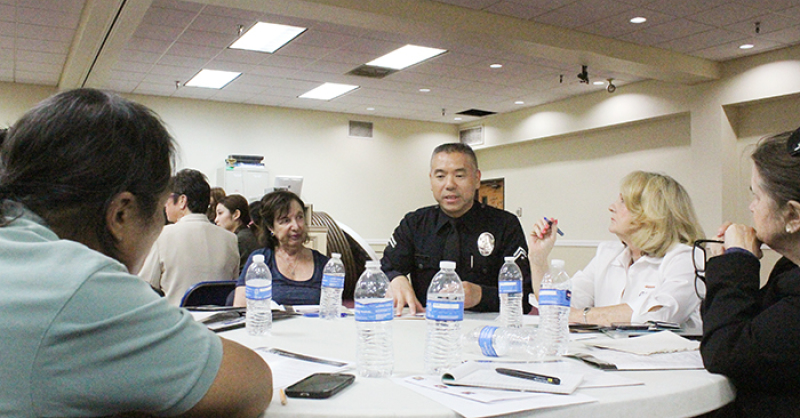
Korean Churches for Community Development (KCCD), along with co-host American Civil Liberties Union of California (ACLU), hosted "Days of Dialogue: Future of Policing' on Tuesday, August 11 at Oriental Mission Church in Koreatown, Los Angeles. This event is a part of the Institute for Nonviolence in Los Angeles (INVLA)'s Days of Dialogue program, a platform for community members and leaders from different organizations and government positions, including the Los Angeles Police Department (LAPD), to gather and exchange perspectives on issues surrounding policing and its effect on the community.
Community members, leaders from various communities, government representatives, and police officers were placed in groups of six to eight people, in which they were able to discuss police violence and how both the police department and the community at large can be informed of both sides' perspectives. Various issues were raised, from gun control to civilian oversight.
Howard Chun, a student at UCLA, expressed concern about the fact that there seems to be no nationwide procedure for the use of lethal force, believing that the use of such force is often disproportionate to the offense committed.
"Can't police use less lethal means, like a taser, before turning to using their guns, or at least shoot the person in the knee?" asked Chun.
Commander Andrew Smith from the Media Relations and Community Affairs group at the LAPD agreed with Chun, saying "We [do] need to make sure officers use less lethal forces before busting out a gun." However, he also expressed his own concerns by commenting that tasers are often ineffective at neutralizing a person who is a threat.
"Our policy is "shoot to stop,'" Smith assured.
Officer Danny Chao from the LAPD, said, "In the moments when you think you have to use of force, you have a split second to make a decision." He mentioned their policy as well, echoing Smith. "We are not trained to shoot to kill. [But] to serve and protect, to stop the threats," Chao said.
The use of body cameras for increased police accountability was a part of the discussion as well. Commander Smith expressed positive regard for the use of body cameras.
"It's protected [police officers] from false complaints," Smith said.
The question of whether it would be wise to show body camera footage to the public garnered mixed opinions.
"The public has the right to know," one KCCD staff member asserted.
A female student from Georgetown University was concerned about whether giving the public access to footage would prevent officers from taking action out of fear of doing something wrong.
"Wouldn't officers be more hesitant to be proactive with body cameras?" she asked.
During the opening of the event, Esther Lim, the Jails Project Director at ACLU, asserted that what may be more important than using advanced technology like body cameras is collection of data and the engagement between the officers and the members in the community.
"We have more info on shark bites than police engagement with community," Lim remarked. "It's not just about technological advancements, but about how the police enforcement engages with the community."
Karen Goldberg, a representative from the Department of Mental Health who was also there simply as an interested citizen, recalled a short encounter with a police officer in her neighborhood that left a positive impression.
"The officer just said hi and asked how I'm doing," Goldberg said, noting what police engagement would look like on a small scale.
Smith mentioned a program--Operation Cul-de-Sac--that showed what police and community engagement could look like on a larger scale. The program, which ran from January 1990 to December 1991, was designed to address the problem of gang violence in high-crime areas in South Central Los Angeles by installing traffic barriers to block access to major streets. As a part of the program, community police projects were implemented by which 15 officers were assigned to get to know the residents and the surrounding neighborhood. By the second year of the program, funding was reduced and supplemental community police projects were discontinued.
"If the program worked, why wasn't it continued and applied to other neighborhoods?" a KCCD staff member asked.
Smith noted that the program is very resource-intensive. It requires more time, money, and human resources than the police department can afford.
"We rarely have the opportunity connect with the people we encounter. We get so many calls in a day-- we're running from scene to scene either catching the "bad guy' or writing down reports and it's on to the next scene. At the end of the day, we turn in the reports and repeat the same thing the next day," said Smith.
Pastor Karen Erickson, founder and CEO of About Our Father's Business, mentioned CompStat meetings that are held every 6 weeks at the LAPD headquarters. During the meeting, executives from the police department review crime statistics and address how to tackle any spikes in crime that the statistics show.
Erickson further mentioned the Citizen Community Police Academy, which provides community members the opportunity to partner with the Department. The academy is an eleven-week program with classes on the LAPD, its history, and an overview of the LAPD's policies and procedures.



















